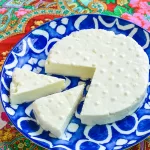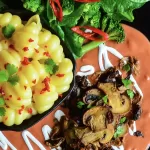I can hardly remember any Easter from my childhood where Hot Cross Buns did not feature. Even when we were living in Daharki, with nary a Hot Cross Bun providing bakery anywhere, my maternal Grandmother would either send or bring us the buns from either Misquita Bakers or sometimes from Lawrence Bakers, both in Karachi, so we could have them for Good Friday.

Dough for the Hot Cross Buns after the first rise
Easter in Lahore meant that my paternal Grandmother would get Hot Cross Buns for the family from Mohkam Din Bakers. I believe Shezan Bakers too used to make Hot Cross Buns around Easter time though I’m not sure.
This year I decided to have a go at making homemade Hot Cross Buns and to make it a yearly Easter tradition, provided they turned out well.

The dough cut into pieces for forming the buns
I’m happy to say that my family and I quite loved my homemade Hot Cross Buns and I shall try to make these every Easter from now on.
I followed respected British food expert Delia Smith’s Hot Cross Bun recipe. Miss Smith’s cookery shows on BBC Good Food are some of my earliest memories of British tv cooking which is why I decided to follow her traditional Hot Cross Bun recipe.

The dough balls placed well apart in a buttered pan, to allow room for expansion
Thoughts And Tips On Making Hot Cross Buns
- There are some very deliciously innovative variations of Hot Cross Buns now, including the savoury variety.
I made a Savoury Hot Cross Bun Ring for Easter ‘22, using this same base recipe but by giving it a savoury twist. I will share that version soon hopefully. - This one here is perhaps one of the most traditional Hot Cross Bun recipes out there and it is spicy and fruity in that comfortingly old-fashioned sort of way that is hard to beat.
- I like to bake these Hot Cross Buns until they are deep golden brown so that the pale pastry crosses show prominently against the dark bun tops in stark contrast.
- The sugar glaze brushed on the buns at the end is essential in my opinion as it provides the final shining touch.
- Hot Cross Buns can easily be frozen if you decide to make them in advance, thus leaving you time to do other things during the busy week leading up to Easter.
- Simply thaw frozen Hot Cross Buns completely in the fridge and reheat in the oven for a few minutes before slicing.
- Hot Cross Buns taste best spread with soft butter and enjoyed with a cup of hot tea.

The dough balls after the second rising; they have almost doubled in size, have the pastry crosses pressed onto them and are finally ready to go into the oven
The recipe has quite a few steps, but I assure you that it is not difficult at all and every point that has been listed down at each stage is just to make it easier for you and to ensure that your Hot Cross Buns turn out wonderful.

Hot Cross Buns
Recipe Type: Breakfast & Brunch Author: Alice In Eatland
Prep Time: 1 – 2 Hours Cook Time: 15 – 20 Minutes
Serves: 8
Fruity, spicy & utterly delicious, nothing says Easter more than these easy to make traditional Hot Cross Buns spread with butter & enjoyed with tea!
INGREDIENTS FOR THE BUNS
- 2 (around 3″ each) cinnamon sticks
- 6 – 8 cloves
- 1 blade mace
- 250 grams flour
- 1/2 teaspoon fine sea salt OR regular salt
- 1/2 teaspoon ginger powder
- A good grating of nutmeg
- 55 grams black currants, stemmed if necessary
- 25 grams candied peel, chopped
- 25 grams soft butter
- 2 1/2 tablespoons milk
- 1 egg
- 1/3 cup water
- 2 tablespoons granulated sugar
- 2 teaspoons instant yeast *
- Extra flour
- Extra milk
INGREDIENTS FOR THE CROSSES
- 20 grams flour
- 5 grams butter, soft but cool
- A few teaspoons cold water
INGREDIENTS FOR THE GLAZE
- 1/2 tablespoon granulated sugar
- 1 tablespoon water
METHOD
- Put the cinnamon sticks, cloves and mace in a small coffee grinder and grind as finely as possible. Sieve.
- Stir flour, salt, ginger powder, nutmeg, currants and chopped candied peel and sieved ground spices until combined.
- Heat the butter and milk in a small pan or in a microwaveable bowl until butter melts. Cool 5 minutes and quickly whisk in the egg. Make sure the liquid isn’t too warm or the egg might scramble in it.
- Heat the water until warm enough that you can comfortably submerge your finger in it (about 105 degrees F – 110 degrees F).
- Stir in the sugar and then sprinkle the yeast on the surface. Let sit without stirring 2 – 5 minutes or until the mixture smells yeasty and begins to form a creamy foam around the edges.
- Once that happens give a quick stir and let sit another 2 – 5 minutes or until the yeast begins to gently bubble up in places and the mixture begins to foam up. This stage is crucial and if it doesn’t happen, your buns may not rise.
- Stir yeast mixture into the butter, milk and egg mixture until combined.
- Make a well in the centre of the combined dry ingredients and pour in the wet mixture. Mix with a large spoon or spatula or with a dough hook if using a stand mixer.
- When the ingredients are mixed, the dough should come together, be elasticky and the bowl should be clean. If the dough is too sticky, add some of the extra flour. If it seems too dry, add extra milk, a teaspoon at a time.
- Knead 1 – 2 minutes by hand on a floured work surface and then put dough into a large oiled bowl.
- Brush oil onto the entire surface of your dough ball to prevent any skin from forming, cover tightly with a tea towel or plastic wrap and let sit in a warm, draft free place (like in a switched off oven or in an off microwave) for 1 – 2 hours or until dough rises to almost double its size.
- Turn out the risen dough onto a lightly floured work surface.
- Punch out the air from the dough, roll it lightly into a longish oblong between your hands on the work surface and cut into eight roughly equal pieces.
- Roll each piece into a smooth round ball and arrange all the dough balls in a buttered baking pan, leaving enough room between the balls for expansion.
- Cover the dough balls in the pan loosely with plastic wrap and let sit again in a warm place until they almost double in size.
- To make the crosses, rub the butter into the flour until like breadcrumbs. Add a little cold water, a bit at a time, mixing until the dough comes together. Roll out thinly, using a little flour to stop sticking if necessary and cut into 16 strips, each strip about 3″ – 4″ long.
- Preheat oven to 220 degrees C / 428 degrees F.
- Once the dough balls have risen, brush the pastry strips with water to make them stick and place on top of each dough ball, making crosses and pressing lightly.
- Bake the buns until golden brown. This can take anywhere from 15 minutes to more depending on your oven.
- While the buns are baking, make the glaze by swirling the sugar and water together in a small pan until the sugar has dissolved and a clear syrup forms. Remove from heat.
- When the buns are done, remove from the oven and brush immediately with the prepared glaze.
- Cool completely on a wire rack and store airtight. The buns can also be frozen airtight at this point.
- Serve warm, lightly toasted if wished, with butter.
* Proofing instant yeast may seem unnecessary but personally I have never had an entirely satisfactory rise using this type of yeast without proofing / blooming it in warm sugared water. Hence the additional proofing step in the recipe.
This step also ensures that you know that the yeast you are using is active and not dead, thus saving you from ruining your buns and wasting your ingredients, time and effort. Trust me – I know from personal experience.






Leave a Reply